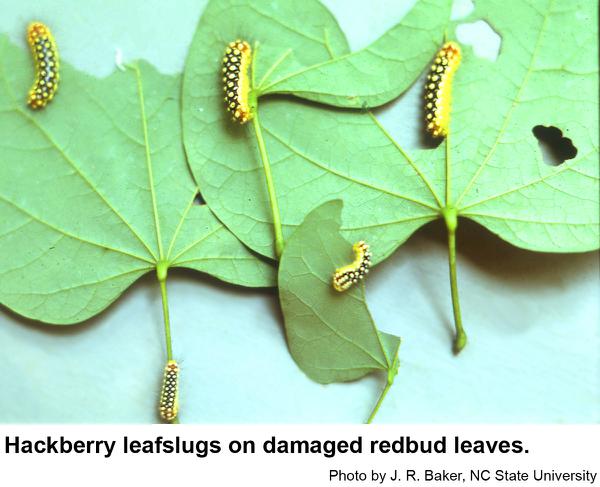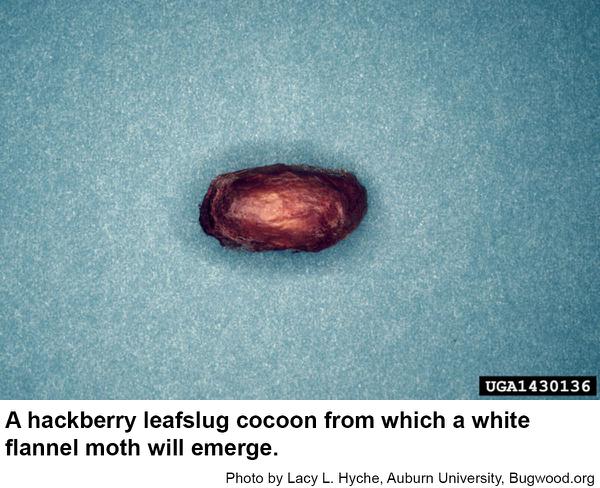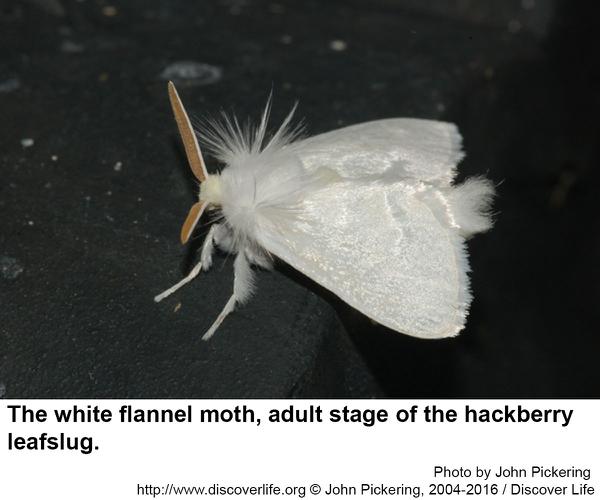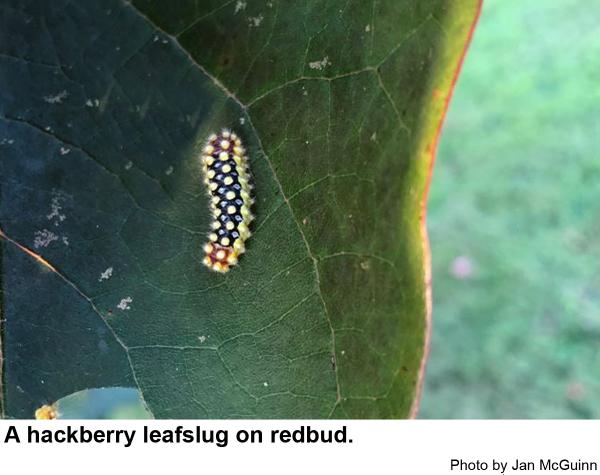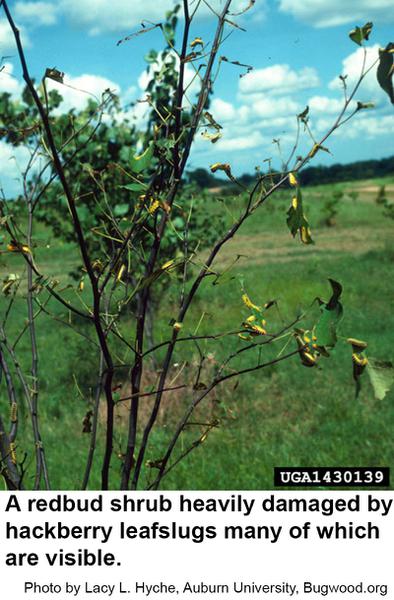Description and Biology
The hackberry leafslug, Norape ovina, is one of the stinging caterpillars more often associated with redbud than hackberry as hackberry is uncommon in landscapes in North Carolina. It is the immature stage of the white flannel moth, a pure white, fluffy moth. These moths apparently emerge sometime during the summer to lay eggs in linear groups on hackberry, redbud, beech or mimosa. From the eggs hatch tiny caterpillars that have a few long, plumose setae (hair-like structures). On larger hackberry leafslugs, the long setae are more noticeable, and they have a short, heavy spine adjacent to each spiracle. This caterpillar is about an inch long when fully grown. The back has a long, dark patch that is punctuated by 7 pairs of conspicuous yellow to white spots with intervening small, white spots. At both end, the dark patch has a rusty red patch also with spots. Below the patch, the caterpillar is yellow. The larvae feed in groups when small but then branch out on their own. When mature, the caterpillars crawl to the ground and pupate in a cocoon just below the soil surface. Although this is one of the more common pests of redbud, at any one location the hackberry leafslug is relatively rare (except for an occasional outbreak). We have two generations per year in North Carolina.
Host Plants
Hackberry leafslugs have been collected from hackberry, beech, black locust, elm, green briar, mimosa and redbud. They have also been reported by victims of their stings. The initial sting is equivalent to that of a wasp or bee. The pain lasts a few hours, but the venom may cause blisters at the sting site. Merely brushing bare skin against the caterpillar breaks urticating hairs that release a venom that causes pain way out of proportion to the size of the insect.
Residential Recommendations
Insect populations are notoriously variable. Next year these caterpillars may not appear at all due to parasites and diseases. Sevin or some other contact insecticide labeled for landscape use should give adequate control. Washing the site of the sting is recommended to remove any residual venom and urticating hairs.
References
- Insect and Other Pests of People and Animals, 2nd edition. Baker, J. R., C.S. Apperson, and J. J. Arends, editors. 2000. N.C. Cooperative Extension Service Bull. No. AG-369. 92 pp.
- Urticating Caterpillars in Florida: 3. Puss Caterpillar and Flannel Moths (Lepidoptera: Megalopygidae). Heppner, J. B. 1997. Entomology Circular No.381 Florida Dept. Agric. & Consumer Services, Division of Plant Industry.
- Stinging caterpillars - White flannel moth, Norape ovina, and Saddleback caterpillar, Archaria stimulea. Raupp, M. J. 2012. Bug of the Week. University of Maryland Extension.
- Extension Plant Pathology Publications and Factsheets
- Horticultural Science Publications
- North Carolina Agricultural Chemicals Manual
For assistance with a specific problem, contact your local N.C. Cooperative Extension Center.
This Factsheet has not been peer reviewed.
Publication date: Jan. 10, 2017
Reviewed/Revised: Aug. 23, 2019
Recommendations for the use of agricultural chemicals are included in this publication as a convenience to the reader. The use of brand names and any mention or listing of commercial products or services in this publication does not imply endorsement by NC State University or N.C. A&T State University nor discrimination against similar products or services not mentioned. Individuals who use agricultural chemicals are responsible for ensuring that the intended use complies with current regulations and conforms to the product label. Be sure to obtain current information about usage regulations and examine a current product label before applying any chemical. For assistance, contact your local N.C. Cooperative Extension county center.
N.C. Cooperative Extension prohibits discrimination and harassment regardless of age, color, disability, family and marital status, gender identity, national origin, political beliefs, race, religion, sex (including pregnancy), sexual orientation and veteran status.

